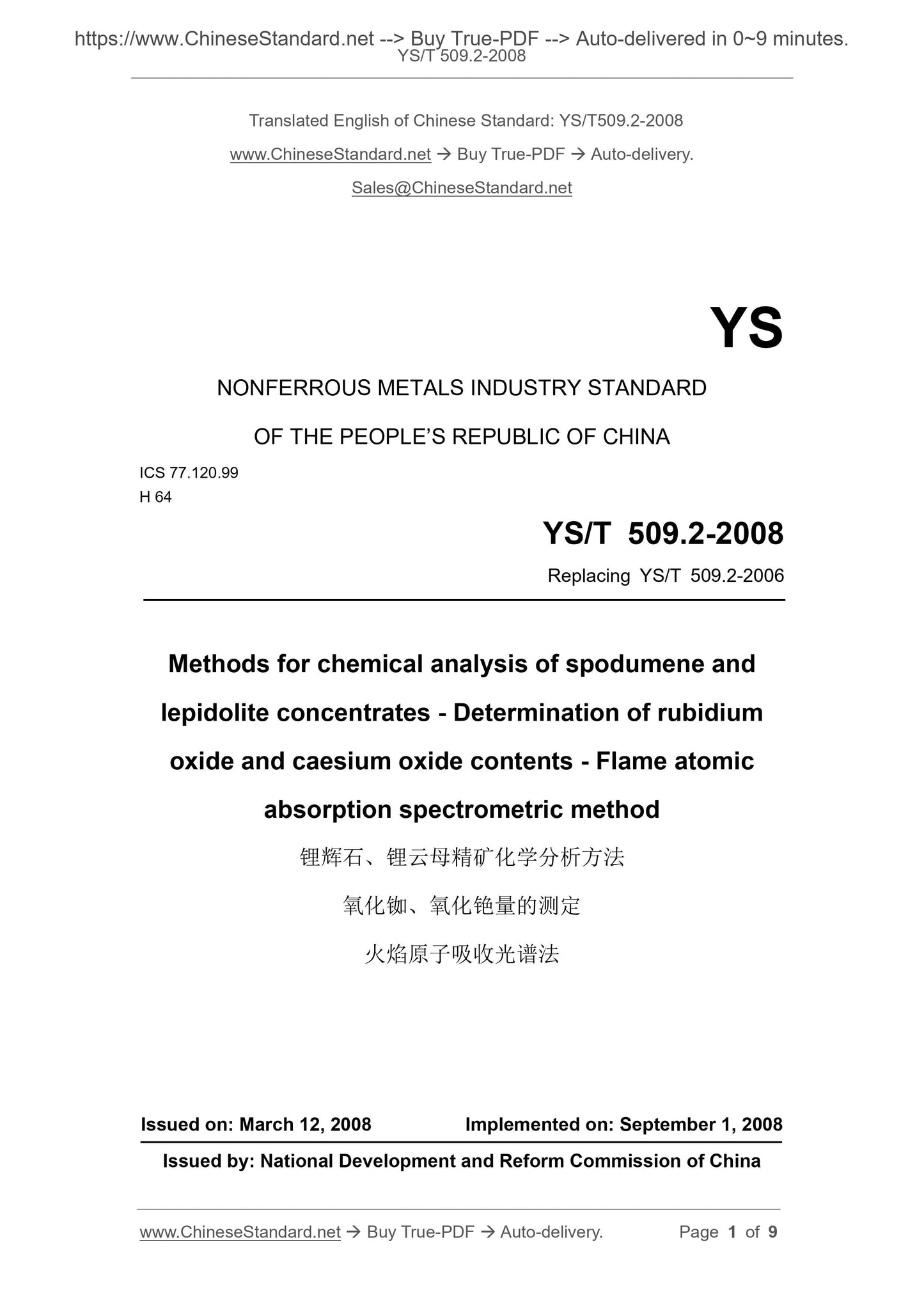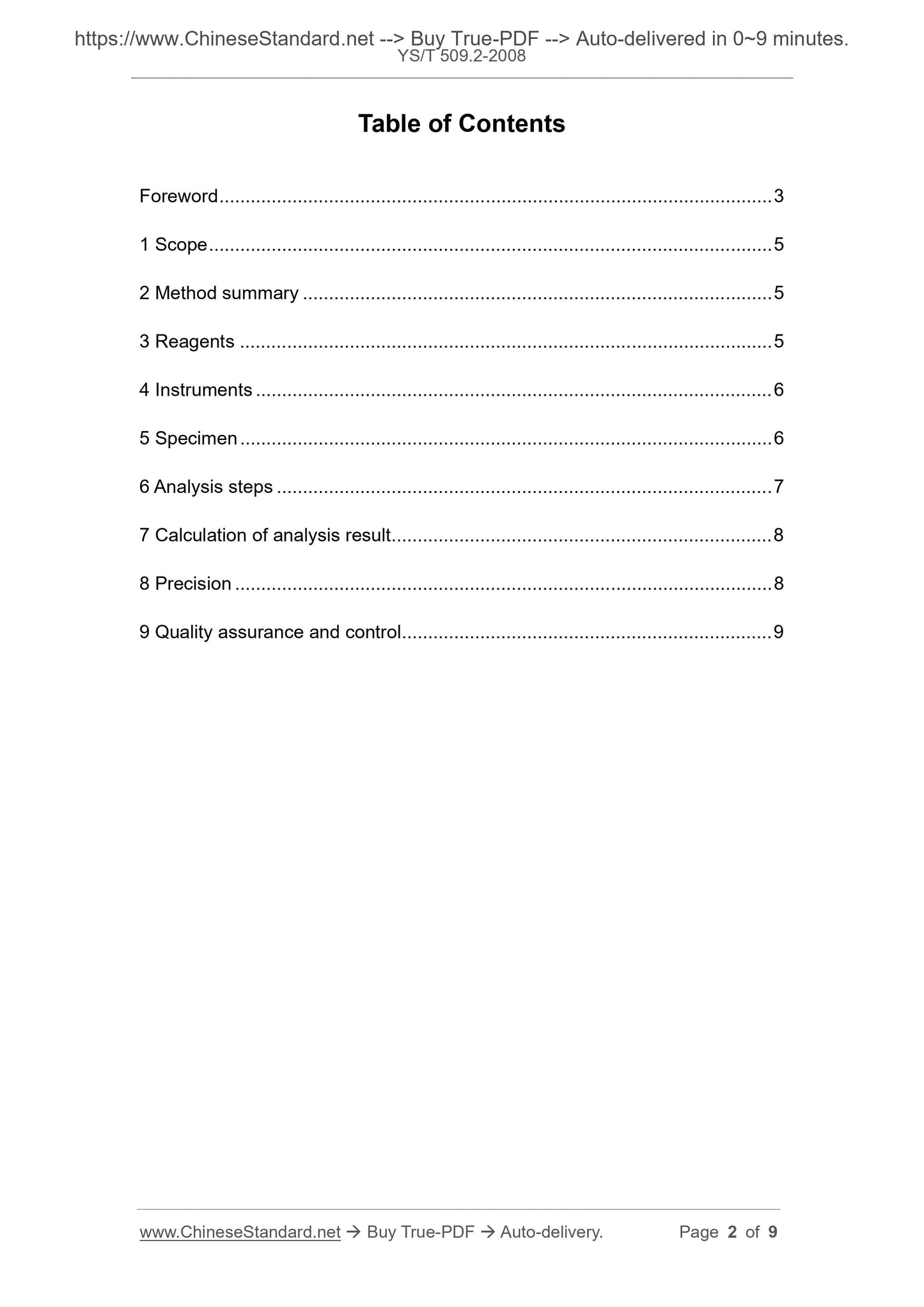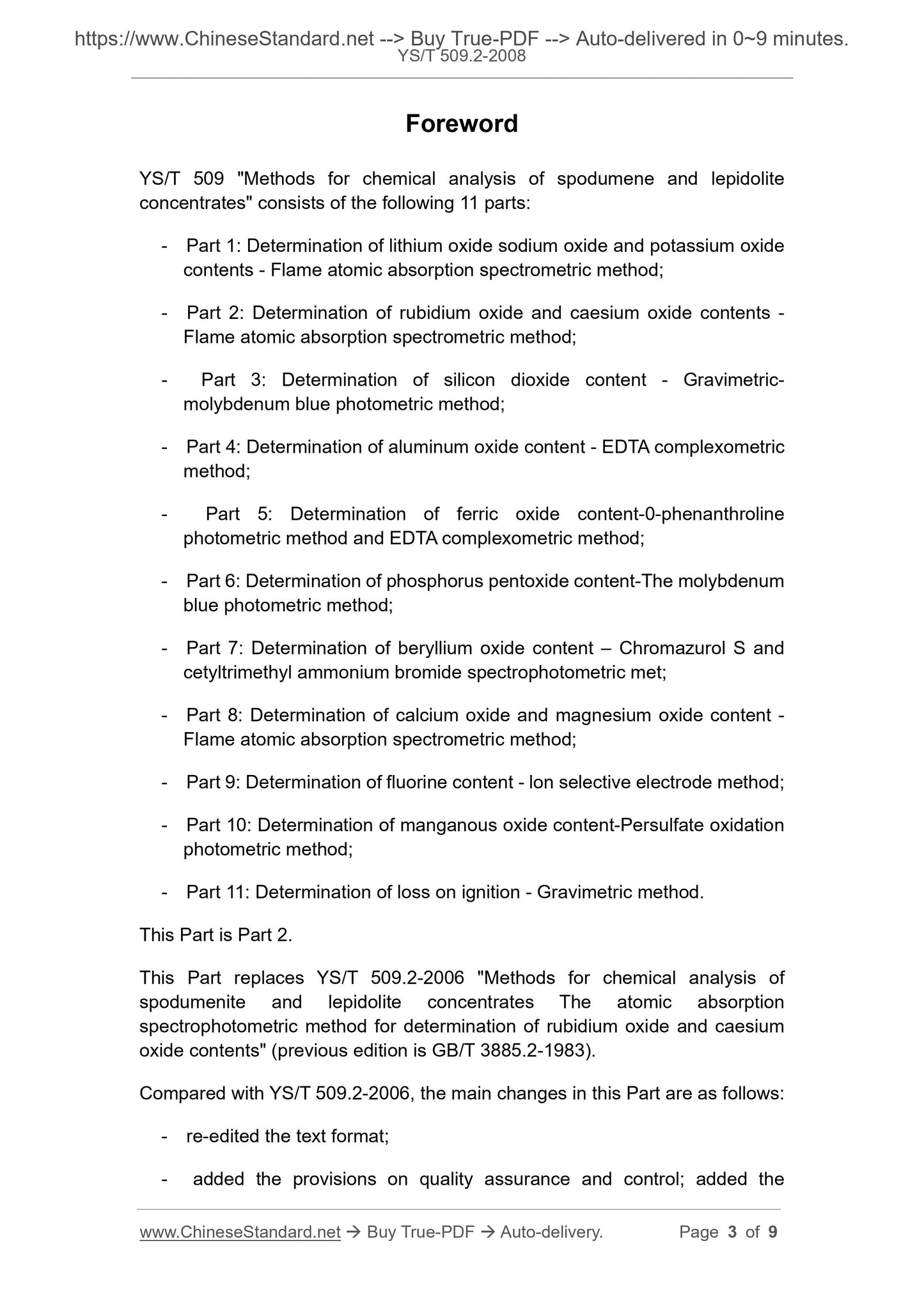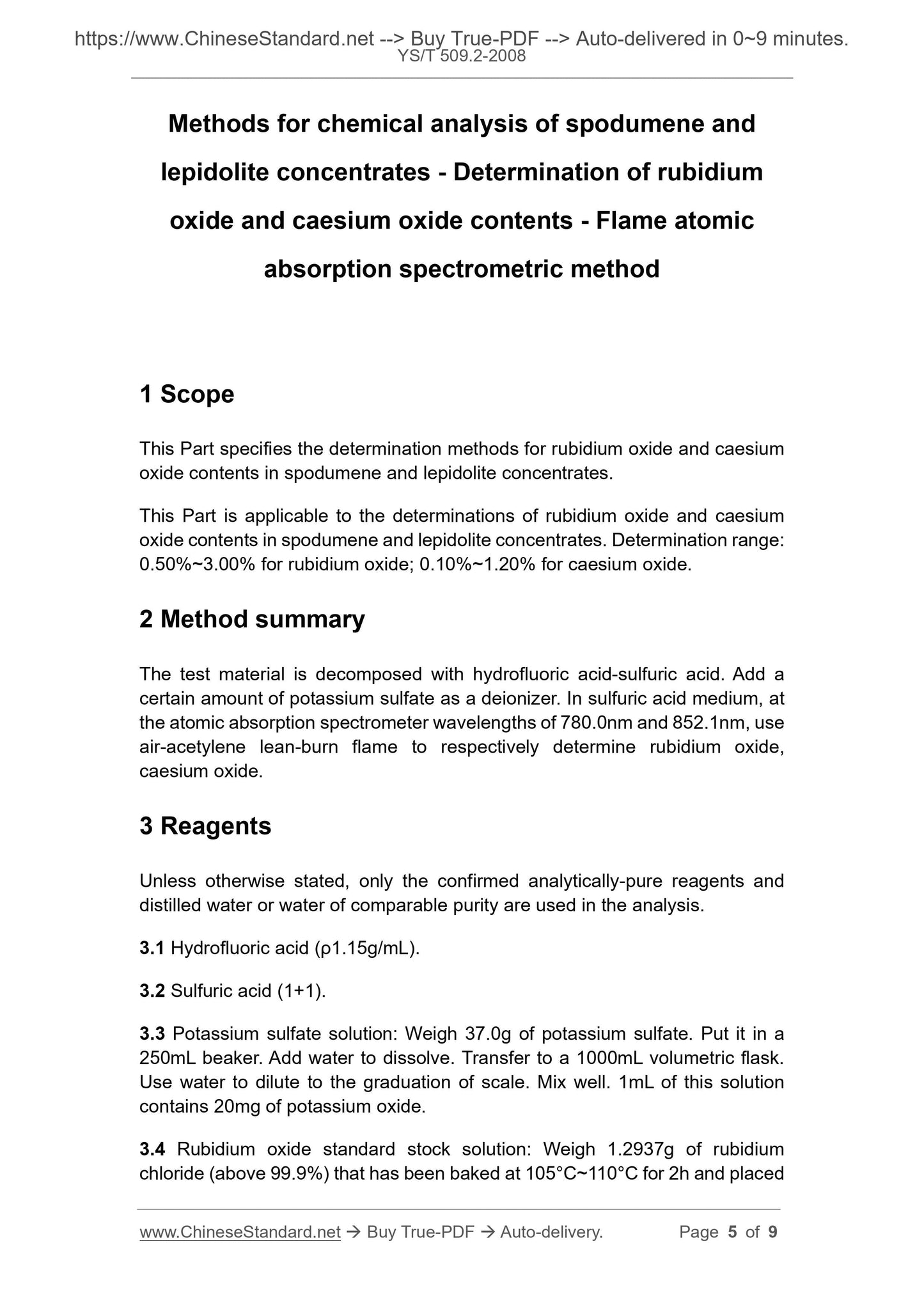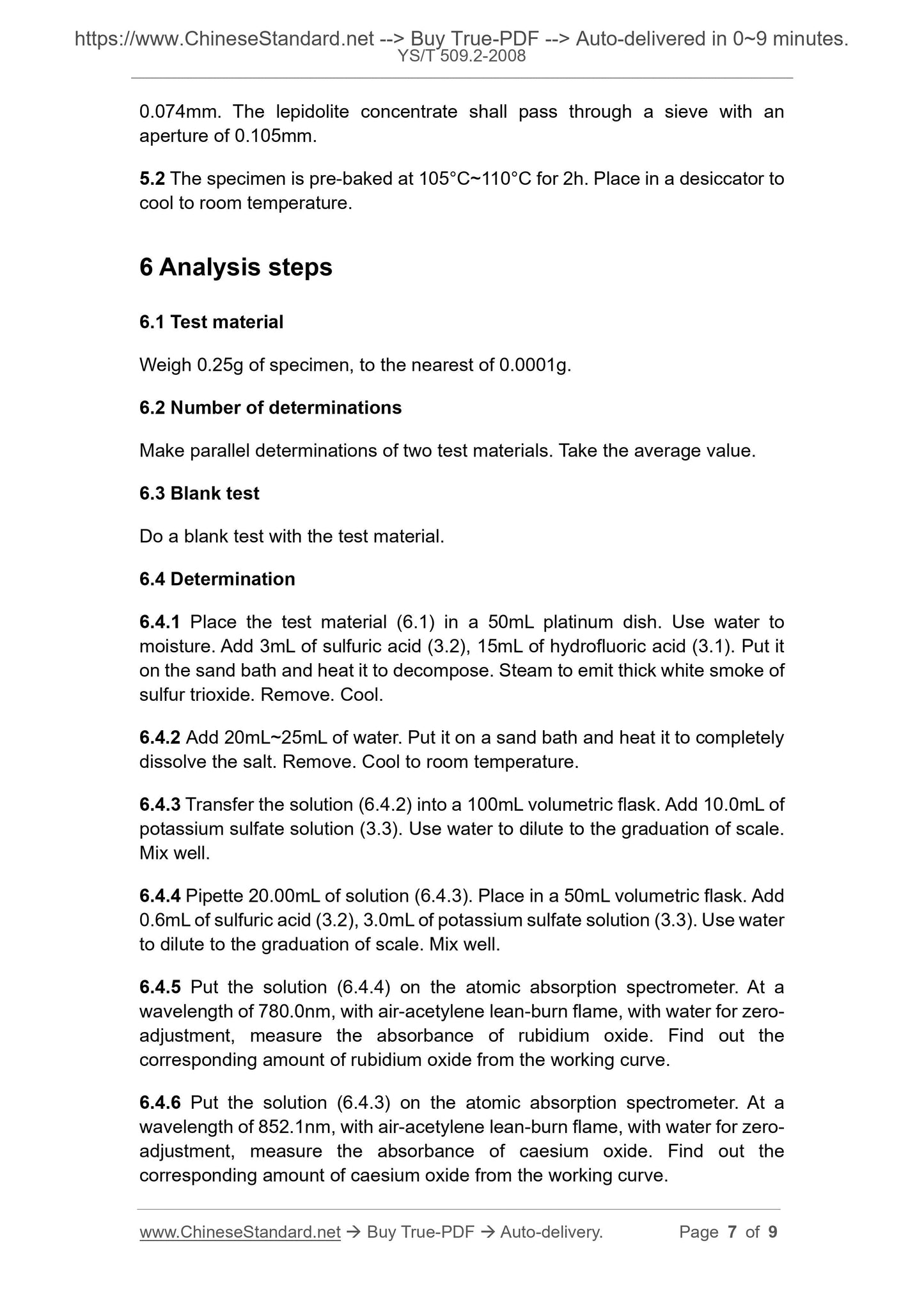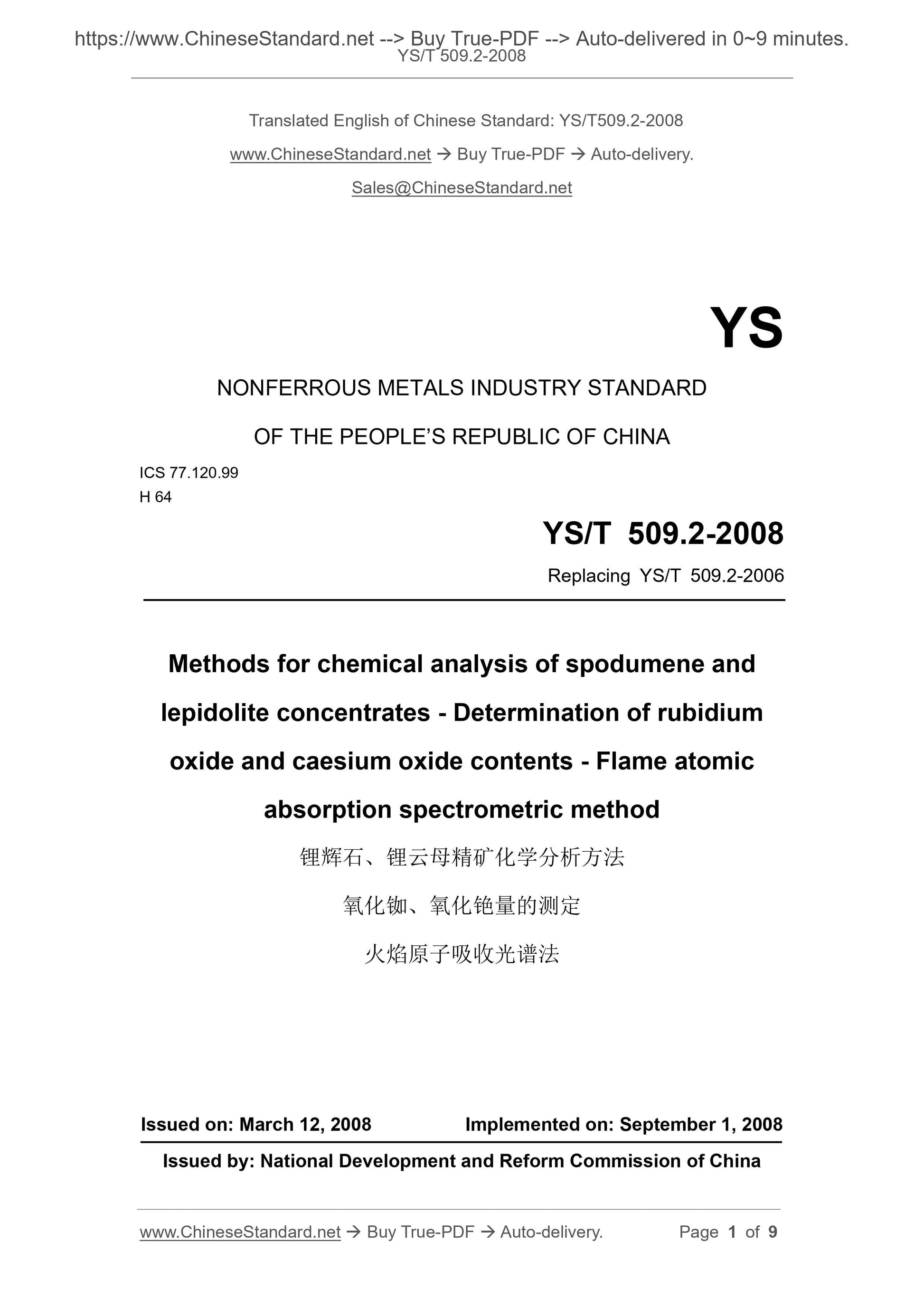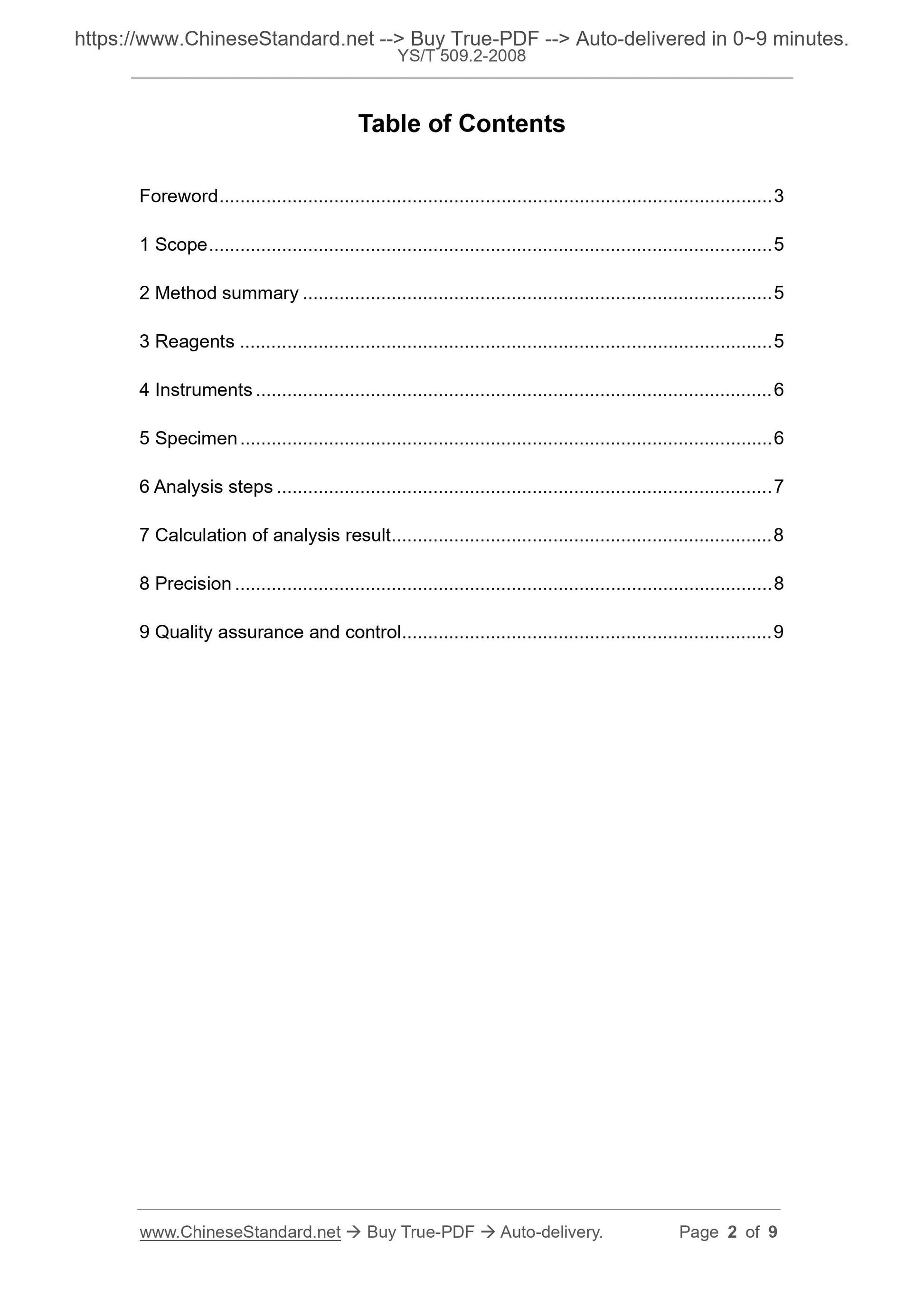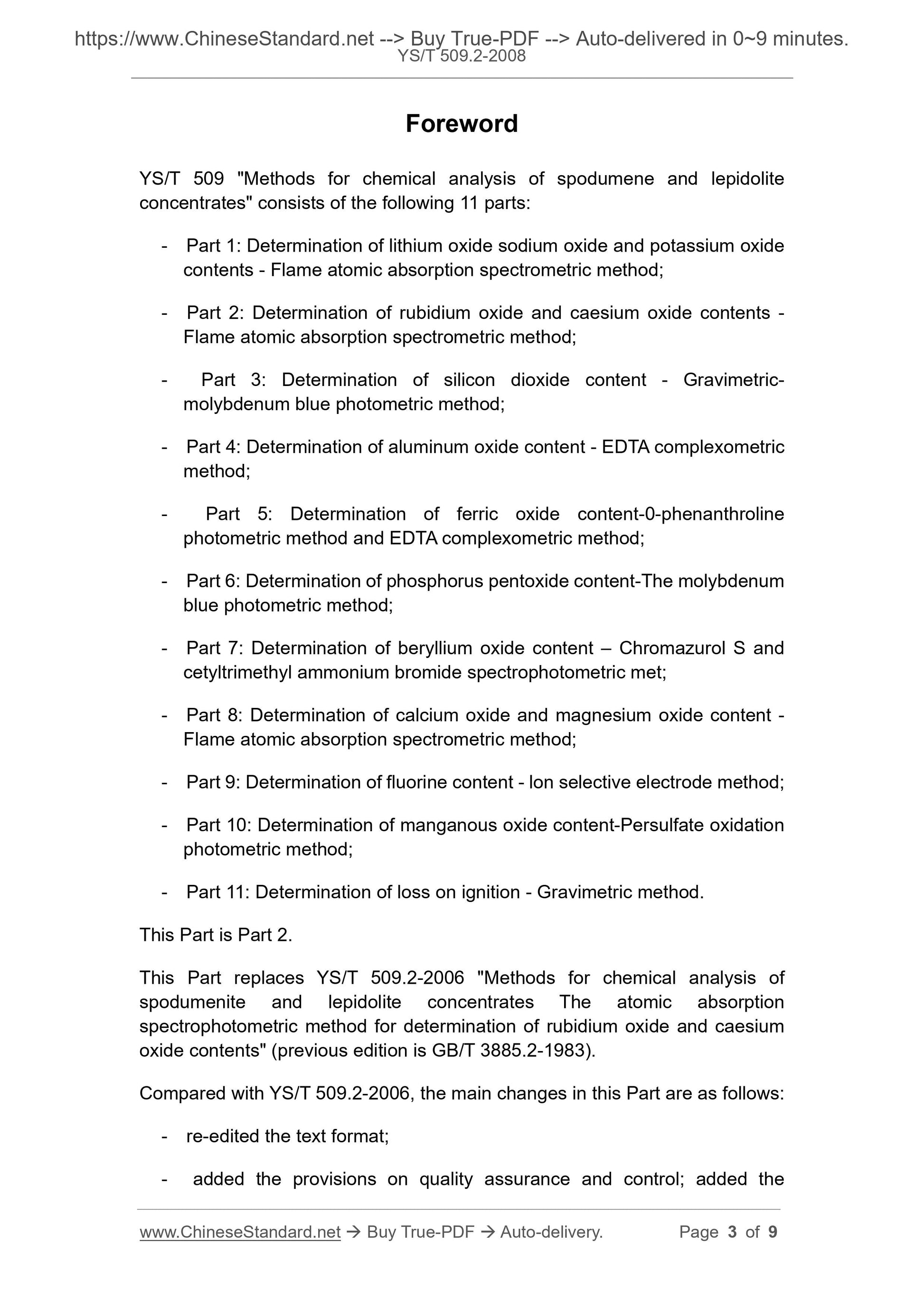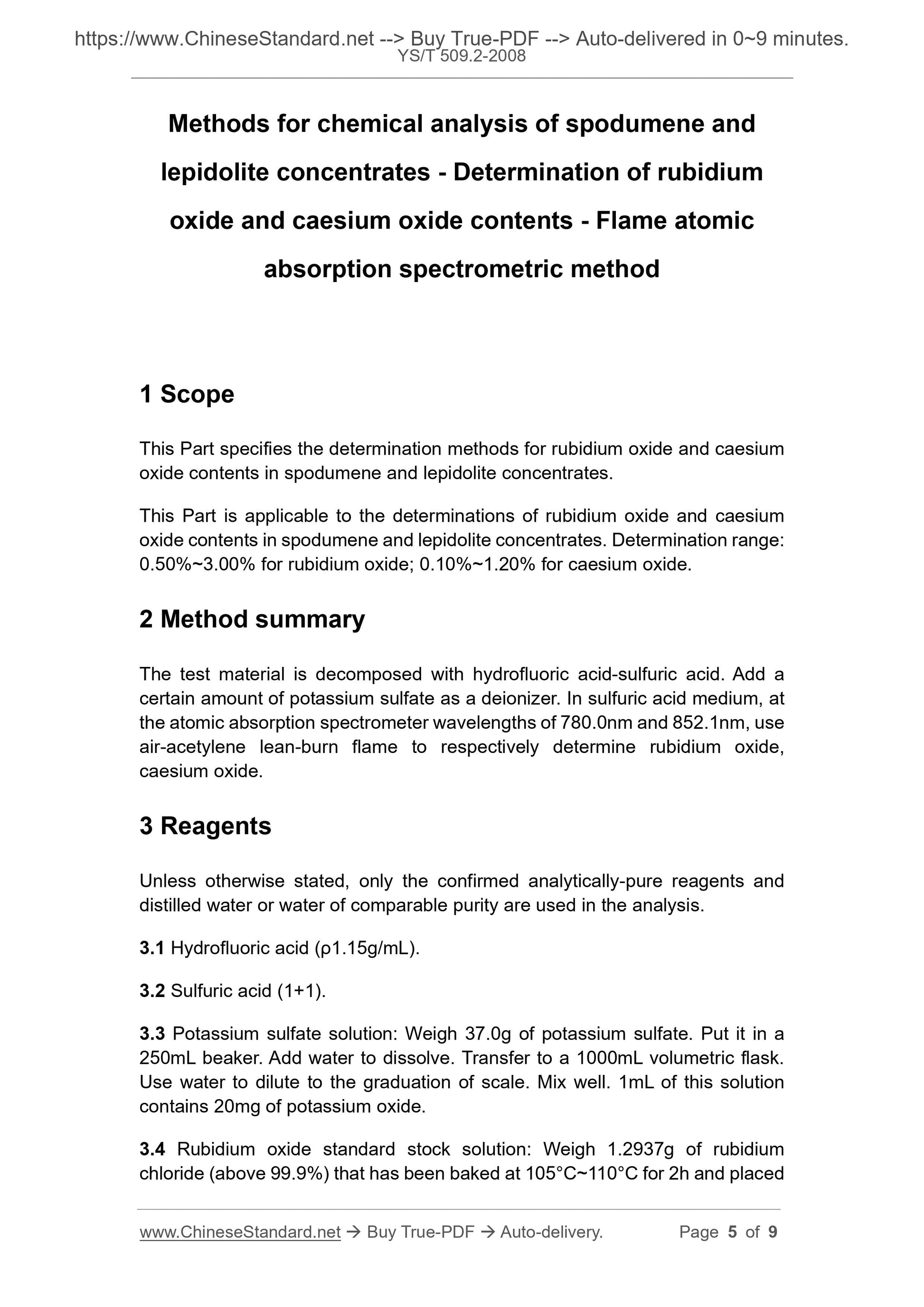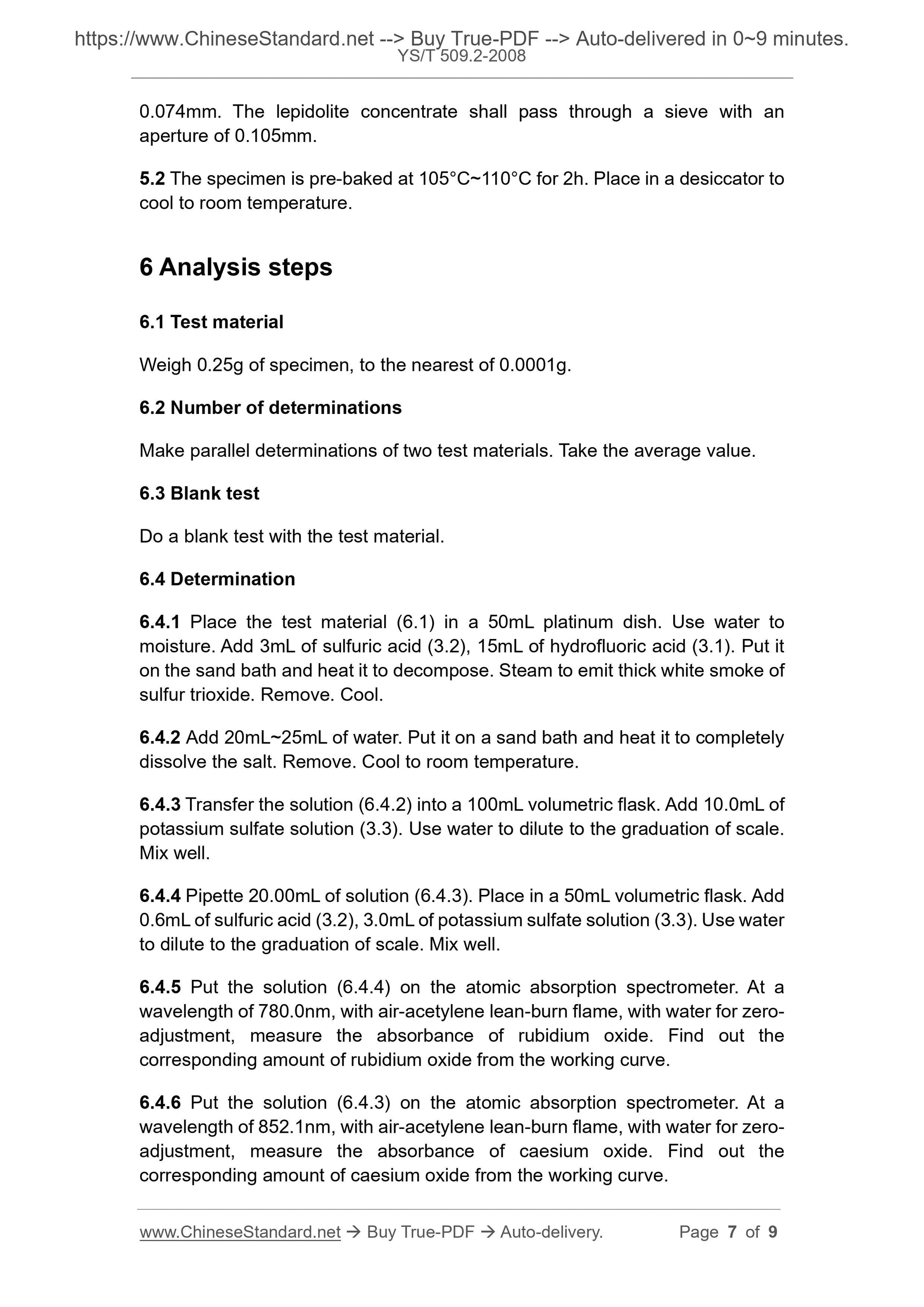1
/
dari
5
PayPal, credit cards. Download editable-PDF and invoice in 1 second!
YS/T 509.2-2008 English PDF (YST509.2-2008)
YS/T 509.2-2008 English PDF (YST509.2-2008)
Harga reguler
$150.00 USD
Harga reguler
Harga obral
$150.00 USD
Harga satuan
/
per
Biaya pengiriman dihitung saat checkout.
Tidak dapat memuat ketersediaan pengambilan
Delivery: 3 seconds. Download true-PDF + Invoice.
Get QUOTATION in 1-minute: Click YS/T 509.2-2008
Historical versions: YS/T 509.2-2008
Preview True-PDF (Reload/Scroll if blank)
YS/T 509.2-2008: Methods for chemical analysis of spodumene and lepidolite concentrates. Determination of rubidium oxide and caesium oxide contents. Flame atomic absorption spectrometric method
YS/T 509.2-2008
YS
NONFERROUS METALS INDUSTRY STANDARD
OF THE PEOPLE’S REPUBLIC OF CHINA
ICS 77.120.99
H 64
Replacing YS/T 509.2-2006
Methods for chemical analysis of spodumene and
lepidolite concentrates - Determination of rubidium
oxide and caesium oxide contents - Flame atomic
absorption spectrometric method
ISSUED ON: MARCH 12, 2008
IMPLEMENTED ON: SEPTEMBER 1, 2008
Issued by: National Development and Reform Commission of China
Table of Contents
Foreword ... 3
1 Scope ... 5
2 Method summary ... 5
3 Reagents ... 5
4 Instruments ... 6
5 Specimen ... 6
6 Analysis steps ... 7
7 Calculation of analysis result ... 8
8 Precision ... 8
9 Quality assurance and control ... 9
Foreword
YS/T 509 "Methods for chemical analysis of spodumene and lepidolite
concentrates" consists of the following 11 parts:
- Part 1: Determination of lithium oxide sodium oxide and potassium oxide
contents - Flame atomic absorption spectrometric method;
- Part 2: Determination of rubidium oxide and caesium oxide contents -
Flame atomic absorption spectrometric method;
- Part 3: Determination of silicon dioxide content - Gravimetric-
molybdenum blue photometric method;
- Part 4: Determination of aluminum oxide content - EDTA complexometric
method;
- Part 5: Determination of ferric oxide content-0-phenanthroline
photometric method and EDTA complexometric method;
- Part 6: Determination of phosphorus pentoxide content-The molybdenum
blue photometric method;
- Part 7: Determination of beryllium oxide content – Chromazurol S and
cetyltrimethyl ammonium bromide spectrophotometric met;
- Part 8: Determination of calcium oxide and magnesium oxide content -
Flame atomic absorption spectrometric method;
- Part 9: Determination of fluorine content - lon selective electrode method;
- Part 10: Determination of manganous oxide content-Persulfate oxidation
photometric method;
- Part 11: Determination of loss on ignition - Gravimetric method.
This Part is Part 2.
This Part replaces YS/T 509.2-2006 "Methods for chemical analysis of
spodumenite and lepidolite concentrates The atomic absorption
spectrophotometric method for determination of rubidium oxide and caesium
oxide contents" (previous edition is GB/T 3885.2-1983).
Compared with YS/T 509.2-2006, the main changes in this Part are as follows:
- re-edited the text format;
- added the provisions on quality assurance and control; added the
Methods for chemical analysis of spodumene and
lepidolite concentrates - Determination of rubidium
oxide and caesium oxide contents - Flame atomic
absorption spectrometric method
1 Scope
This Part specifies the determination methods for rubidium oxide and caesium
oxide contents in spodumene and lepidolite concentrates.
This Part is applicable to the determinations of rubidium oxide and caesium
oxide contents in spodumene and lepidolite concentrates. Determination range:
0.50%~3.00% for rubidium oxide; 0.10%~1.20% for caesium oxide.
2 Method summary
The test material is decomposed with hydrofluoric acid-sulfuric acid. Add a
certain amount of potassium sulfate as a deionizer. In sulfuric acid medium, at
the atomic absorption spectrometer wavelengths of 780.0nm and 852.1nm, use
air-acetylene lean-burn flame to respectively determine rubidium oxide,
caesium oxide.
3 Reagents
Unless otherwise stated, only the confirmed analytically-pure reagents and
distilled water or water of comparable purity are used in the analysis.
3.1 Hydrofluoric acid (ρ1.15g/mL).
3.2 Sulfuric acid (1+1).
3.3 Potassium sulfate solution: Weigh 37.0g of potassium sulfate. Put it in a
250mL beaker. Add water to dissolve. Transfer to a 1000mL volumetric flask.
Use water to dilute to the graduation of scale. Mix well. 1mL of this solution
contains 20mg of potassium oxide.
3.4 Rubidium oxide standard stock solution: Weigh 1.2937g of rubidium
chloride (above 99.9%) that has been baked at 105°C~110°C for 2h and placed
0.074mm. The lepidolite concentrate shall pass through a sieve with an
aperture of 0.105mm.
5.2 The specimen is pre-baked at 105°C~110°C for 2h. Place in a desiccator to
cool to room temperature.
6 Analysis steps
6.1 Test material
Weigh 0.25g of specimen, to the nearest of 0.0001g.
6.2 Number of determinations
Make parallel determinations of two test materials. Take the average value.
6.3 Blank test
Do a blank test with the test material.
6.4 Determination
6.4.1 Place the test material (6.1) in a 50mL platinum dish. Use water to
moisture. Add 3mL of sulfuric acid (3.2), 15mL of hydrofluoric acid (3.1). Put it
on the sand bath and heat it to decompose. Steam to emit thick white smoke of
sulfur trioxide. Remove. Cool.
6.4.2 Add 20mL~25mL of water. Put it on a sand bath and heat it to completely
dissolve the salt. Remove. Cool to room temperature.
6.4.3 Transfer the solution (6.4.2) into a 100mL volumetric flask. Add 10.0mL of
potassium sulfate solution (3.3). Use water to dilute to the graduation of scale.
Mix well.
6.4.4 Pipette 20.00mL of solution (6.4.3). Place in a 50mL volumetric flask. Add
0.6mL of sulfuric acid (3.2), 3.0mL of potassium sulfate solution (3.3). Use water
to dilute to the graduation of scale. Mix well.
6.4.5 Put the solution (6.4.4) on the atomic absorption spectrometer. At a
wavelength of 780.0nm, with air-acetylene lean-burn flame, with water for zero-
adjustment, measure the absorbance of rubidium oxide. Find out the
corresponding amount of rubidium oxide from the working curve.
6.4.6 Put the solution (6.4.3) on the atomic absorption spectrometer. At a
wavelength of 852.1nm, with air-acetylene lean-burn flame, with water for zero-
adjustment, measure the absorbance of caesium oxide. Find out the
corresponding amount of caesium oxide from the working curve.
Get QUOTATION in 1-minute: Click YS/T 509.2-2008
Historical versions: YS/T 509.2-2008
Preview True-PDF (Reload/Scroll if blank)
YS/T 509.2-2008: Methods for chemical analysis of spodumene and lepidolite concentrates. Determination of rubidium oxide and caesium oxide contents. Flame atomic absorption spectrometric method
YS/T 509.2-2008
YS
NONFERROUS METALS INDUSTRY STANDARD
OF THE PEOPLE’S REPUBLIC OF CHINA
ICS 77.120.99
H 64
Replacing YS/T 509.2-2006
Methods for chemical analysis of spodumene and
lepidolite concentrates - Determination of rubidium
oxide and caesium oxide contents - Flame atomic
absorption spectrometric method
ISSUED ON: MARCH 12, 2008
IMPLEMENTED ON: SEPTEMBER 1, 2008
Issued by: National Development and Reform Commission of China
Table of Contents
Foreword ... 3
1 Scope ... 5
2 Method summary ... 5
3 Reagents ... 5
4 Instruments ... 6
5 Specimen ... 6
6 Analysis steps ... 7
7 Calculation of analysis result ... 8
8 Precision ... 8
9 Quality assurance and control ... 9
Foreword
YS/T 509 "Methods for chemical analysis of spodumene and lepidolite
concentrates" consists of the following 11 parts:
- Part 1: Determination of lithium oxide sodium oxide and potassium oxide
contents - Flame atomic absorption spectrometric method;
- Part 2: Determination of rubidium oxide and caesium oxide contents -
Flame atomic absorption spectrometric method;
- Part 3: Determination of silicon dioxide content - Gravimetric-
molybdenum blue photometric method;
- Part 4: Determination of aluminum oxide content - EDTA complexometric
method;
- Part 5: Determination of ferric oxide content-0-phenanthroline
photometric method and EDTA complexometric method;
- Part 6: Determination of phosphorus pentoxide content-The molybdenum
blue photometric method;
- Part 7: Determination of beryllium oxide content – Chromazurol S and
cetyltrimethyl ammonium bromide spectrophotometric met;
- Part 8: Determination of calcium oxide and magnesium oxide content -
Flame atomic absorption spectrometric method;
- Part 9: Determination of fluorine content - lon selective electrode method;
- Part 10: Determination of manganous oxide content-Persulfate oxidation
photometric method;
- Part 11: Determination of loss on ignition - Gravimetric method.
This Part is Part 2.
This Part replaces YS/T 509.2-2006 "Methods for chemical analysis of
spodumenite and lepidolite concentrates The atomic absorption
spectrophotometric method for determination of rubidium oxide and caesium
oxide contents" (previous edition is GB/T 3885.2-1983).
Compared with YS/T 509.2-2006, the main changes in this Part are as follows:
- re-edited the text format;
- added the provisions on quality assurance and control; added the
Methods for chemical analysis of spodumene and
lepidolite concentrates - Determination of rubidium
oxide and caesium oxide contents - Flame atomic
absorption spectrometric method
1 Scope
This Part specifies the determination methods for rubidium oxide and caesium
oxide contents in spodumene and lepidolite concentrates.
This Part is applicable to the determinations of rubidium oxide and caesium
oxide contents in spodumene and lepidolite concentrates. Determination range:
0.50%~3.00% for rubidium oxide; 0.10%~1.20% for caesium oxide.
2 Method summary
The test material is decomposed with hydrofluoric acid-sulfuric acid. Add a
certain amount of potassium sulfate as a deionizer. In sulfuric acid medium, at
the atomic absorption spectrometer wavelengths of 780.0nm and 852.1nm, use
air-acetylene lean-burn flame to respectively determine rubidium oxide,
caesium oxide.
3 Reagents
Unless otherwise stated, only the confirmed analytically-pure reagents and
distilled water or water of comparable purity are used in the analysis.
3.1 Hydrofluoric acid (ρ1.15g/mL).
3.2 Sulfuric acid (1+1).
3.3 Potassium sulfate solution: Weigh 37.0g of potassium sulfate. Put it in a
250mL beaker. Add water to dissolve. Transfer to a 1000mL volumetric flask.
Use water to dilute to the graduation of scale. Mix well. 1mL of this solution
contains 20mg of potassium oxide.
3.4 Rubidium oxide standard stock solution: Weigh 1.2937g of rubidium
chloride (above 99.9%) that has been baked at 105°C~110°C for 2h and placed
0.074mm. The lepidolite concentrate shall pass through a sieve with an
aperture of 0.105mm.
5.2 The specimen is pre-baked at 105°C~110°C for 2h. Place in a desiccator to
cool to room temperature.
6 Analysis steps
6.1 Test material
Weigh 0.25g of specimen, to the nearest of 0.0001g.
6.2 Number of determinations
Make parallel determinations of two test materials. Take the average value.
6.3 Blank test
Do a blank test with the test material.
6.4 Determination
6.4.1 Place the test material (6.1) in a 50mL platinum dish. Use water to
moisture. Add 3mL of sulfuric acid (3.2), 15mL of hydrofluoric acid (3.1). Put it
on the sand bath and heat it to decompose. Steam to emit thick white smoke of
sulfur trioxide. Remove. Cool.
6.4.2 Add 20mL~25mL of water. Put it on a sand bath and heat it to completely
dissolve the salt. Remove. Cool to room temperature.
6.4.3 Transfer the solution (6.4.2) into a 100mL volumetric flask. Add 10.0mL of
potassium sulfate solution (3.3). Use water to dilute to the graduation of scale.
Mix well.
6.4.4 Pipette 20.00mL of solution (6.4.3). Place in a 50mL volumetric flask. Add
0.6mL of sulfuric acid (3.2), 3.0mL of potassium sulfate solution (3.3). Use water
to dilute to the graduation of scale. Mix well.
6.4.5 Put the solution (6.4.4) on the atomic absorption spectrometer. At a
wavelength of 780.0nm, with air-acetylene lean-burn flame, with water for zero-
adjustment, measure the absorbance of rubidium oxide. Find out the
corresponding amount of rubidium oxide from the working curve.
6.4.6 Put the solution (6.4.3) on the atomic absorption spectrometer. At a
wavelength of 852.1nm, with air-acetylene lean-burn flame, with water for zero-
adjustment, measure the absorbance of caesium oxide. Find out the
corresponding amount of caesium oxide from the working curve.
Share
